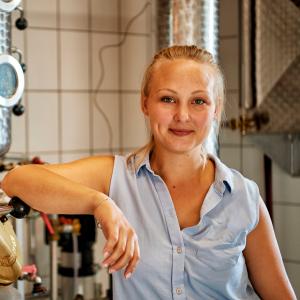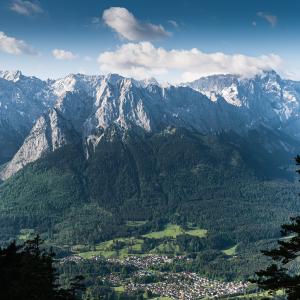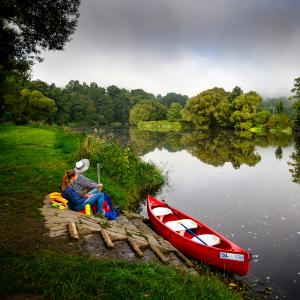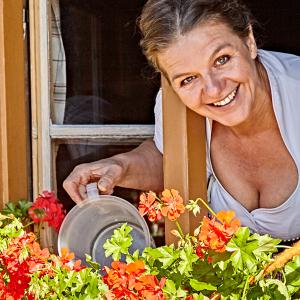In a beer garden it tastes good with brezn (pretzels) and cold food. At the Oktoberfest (Munich beer festival) it is brought to the tables in sturdy mugs. And in inns, raising one's glass to the health of others is an expression of solidarity and conviviality: beer goes with Bavaria like fish with chips.
History of the Bavarian art of brewing
Officially, the amber brew has been made in the Free State since the year 1040, in which the brewing and tapping rights were awarded to Weihenstephan Abbey in Freising near Munich. At the beginning, in general, the art of brewing in Bavaria was mainly developed by monastic breweries. In the Franconian Weltenburg Abbey too, with its romantic location at the Danube Gorge near Kelheim, beer has been brewed since 1050 – right up to the present day! – and also served there. Today, some 640 Bavarian breweries produce the beloved amber nectar, with more than 300 brewing sites in Franconia alone, which means that Franconia can boast the greatest density of breweries, not only in Germany, but in the world as a whole. Regional beer specialities also come from Franconia, for example rauchbier ('smoked beer'), made with smoked malt, and rotbier ('red beer'), which has the fact that it is aged in wooden barrels to thank for its unusual colour. However, the fact that Bavarian beer has such an excellent reputation internationally is not due merely to the tradition, but also to the recipe: since 1516, the purity law has held sway in Bavaria. It says that Bavarian beer is only allowed to be brewed using barley, hops and water. And indeed, that is all it takes in the Free State to brew the best beer in the world!
Enjoy the Bavarian way of life
Sitting together at a long wooden table with a cold meal and a beer – anyone who really wants to understand that Bavarian awareness of life needs to have sat in one of those inns at least once. The inn is part of a proper Bavarian village just as the church and the maypole are, yet what is presumably the best known inn in the world is right in the heart of Munich, with its population of well over a million: in the Hofbräuhaus, the guests sit together cosily in the so-called schwemme and drink their beer out of big mugs to the sounds of brass band music. In East Bavaria, and especially in the Upper Palatinate, private individuals are allowed to brew beer too – the so-called zoiglbier – and to serve it at their home at set intervals. The zoiglstern, a star hung out on the façade of the house, indicates when the bottom-fermented beer is available there. Currently, this kind of brewing is experiencing a real renaissance.
Experiencing the Bavarian art of brewing
If your aim is not to have one over the eight, but to see how the process is actually performed, i.e. if you want to see what goes on in the brewing copper, you should opt for a guided tour like the ones many brewing facilities offer. For example in the Hallertau, the world's largest hop-growing region, where your customers can look over the master brewers' shoulders while they work, perhaps at Kuchlbauer in Abensberg or Zieglerbräu in Mainburg. But at the Bavarian State Brewery Weihenstephan in Freising too, they can have a look behind the scenes and subsequently taste specialities such as the prizewinning Kellerbier 1516. Or what about a visit to the Enzianhütte near Oberstdorf in the Allgäu? Up at an altitude of 1,800 metres – i.e. in Bavaria's highest (mini-)brewery – innkeeper Daniel Engler makes a beer that really goes down well.
Bavarian beer tradition
Having said that, guided tours through the Bavarian beer tradition are also provided in the towns and cities. The beer tour 'Munich and the Beer', for example, winds its way through the old city and visits places which tell of Munich's brewing history. In Bayreuth, the beer tour takes you past the sights worth seeing and straight to "Maisel’s Bier-Erlebnis-Welt". In Nuremberg, in turn, your customers can refresh themselves after a walk through the old city with a freshly tapped Kellerbier, rotbier or schwarzbier in the Altstadthof Craft Brewery.
Munich's Beer and Oktoberfest Museum
Beer can even be drunk during a museum visit in Bavaria! Well, all right, not in all the museums by any means, but in Munich's Beer and Oktoberfest Museum, for example. There, an exhibition narrates the long history of beer, which was already being made from fermented bread dough in the Middle East in the ancient world, and was subsequently developed in Europe by monks. In the Franconian Brewery Museum in Bamberg, in the brewhouse, the malthouse and at other stations, visitors can learn how a refreshing cold drink that goes down really well is made from barley, hops and water.
An overview of all the information:
Tel.: +49 89 2866040
E-mail: brauerbund@bayerisches-bier.de
Tel.: +49 89 24231607
E-mail: info@bier-und-oktoberfestmuseum.de
Asamstraße 32
93309 Kelheim
Tel.: +49 8161 5360
E-mail: info@weihenstephan.de
Tel.: +49 89 921050
E-mail: besichtigung@hofbraeuhaus.com
Tel.: +49 89 233 965 00
Opernstraße 22
95444 Bayreuth
Frauentorgraben 3
90443 Nürnberg
Geyerswörthstraße 5
96047 Bamberg
Tel.: +49 951 53016
E-mail: info@brauereimuseum.de



